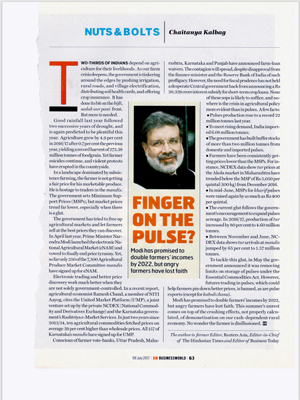FINGER ON THE PULES?
[Business World]
Published date: 8 July 2017
Two-third of indians depend on agriculture for their livelihoods. As our farm crisis deepens, the government is tinkering around the edges by pushing irrigation, rural roads, and village electrification, distributing soil health cards, and offering crop insurance. It has done its bit on the bijli, sadak aur pani front. But more is needed. Good rainfall last year followed two successive years of drought, and is again predicted to be plentiful this year. Agriculture grew by 4.9 per cent in 2016/17after 0.7 per cent the previous year, yielding a record harvest of 273.38 million tonnes of food grain. Yet farmer suicides continue, and violent protests have erupted in the countryside.
In a landscape dominated by subsistence farming, the farmer is not getting a fair price for his marketable produce. He is hostage to traders in the mandis.
The government sets Minimum Sup port Prices (MSPs), but market prices trend far lower, especially when there is a glut.
The government has tried to free up agricultural markets and let farmers sell at the best prices they can discover. In April last year, Prime Minister Narendra Modi launched the electronic National Agricultural Market (eNAM) and vowed to finally end price tyranny. Yet, so far only 250 of the 7,500 Agricultural Produce Market Committee mandis have signed up for eNAM.
Electronic trading and better price discovery work much better when they are not solely government-controlled. In a recent report, agricultural economist Ramesh Chand, a member of NITI Aayog, cites the United Market Platform (UMP), a joint venture set up by the private NCDEX (National Commodity and Derivatives Exchange) and the Karnataka government’s Rashtriya e-Market Services. In just two years since 2013/14, ten agricultural commodities fetched prices on average 39 per cent higher than wholesale prices. All 157 of Karnataka’s mandis have signed up for UMP.
Conscious of farmer vote-banks, Uttar Pradesh, Maharashtra, Karnataka and Punjab have announced farm-loan waivers. The contagion will spread, despite disapproval from the finance minister and the Reserve Bank of lndia of such profligacy. However, the need for fiscal prudence has not held a desperate Central government back from announcing a Rs 20,339 crore interest subsidy for short-term crop loans. None of these sops is likely to suffice, and no where is the crisis in agricultural policy more evident than in pulses. A few facts:
• Pulses production rose to a record 22 million tonnes last year.
• To meet rising demand, India imported 6.08 million tonnes.
• The government has built buffer stocks of more than two million tonnes from domestic and imported pulses.
• Farmers have been consistently getting prices lower than the MSPs. For in stance, NCDEX data show tur prices at the Akola market in Maharashtra have trended below the MSP of Rs 5,050 per quintal (100 kg)from December 2016.
• In mid-June, MSPs for lcharif pulses were raised again by as much as Rs 400 per quintal.
• The current glut follows the government’s encouragement to expand pulses acreage. In 2016/17, production of tur increased by 80 per cent to 4.60 million tonnes.
• Between November and June, NC DEX data shows tur arrivals at mandis jumped by 65 per cent to 1.57 million tonnes.
To tackle this glut, in May the government announced it was removing limits on storage of pulses under the Essential Commodities Act. However, futures trading in pulses, which could help farmers pin down better prices, is banned, as are pulse exports (except for kabuli chana).
Modi has promised to double farmers’ incomes by 2022, but angry farmers have lost faith. This summer’s unrest comes on top of the crushing effects, not properly calculated, of demonetisation on our cash-dependent rural economy. No wonder the farmer is disillusioned.






